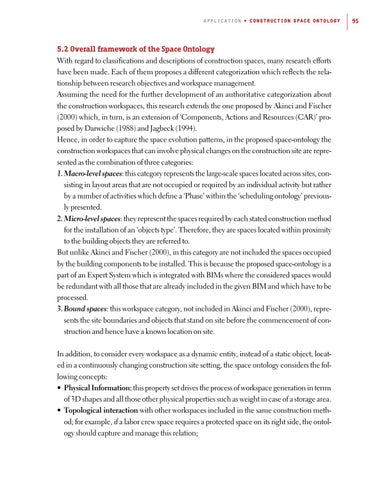application • construction space ontology
5.2 Overall framework of the Space Ontology With regard to classifications and descriptions of construction spaces, many research efforts have been made. Each of them proposes a different categorization which reflects the relationship between research objectives and workspace management. Assuming the need for the further development of an authoritative categorization about the construction workspaces, this research extends the one proposed by Akinci and Fischer (2000) which, in turn, is an extension of ‘Components, Actions and Resources (CAR)’ proposed by Darwiche (1988) and Jagbeck (1994). Hence, in order to capture the space evolution patterns, in the proposed space-ontology the construction workspaces that can involve physical changes on the construction site are represented as the combination of three categories: 1. Macro-level spaces: this category represents the large-scale spaces located across sites, consisting in layout areas that are not occupied or required by an individual activity but rather by a number of activities which define a ‘Phase’ within the ‘scheduling ontology’ previously presented. 2. Micro-level spaces: they represent the spaces required by each stated construction method for the installation of an ‘objects type’. Therefore, they are spaces located within proximity to the building objects they are referred to. But unlike Akinci and Fischer (2000), in this category are not included the spaces occupied by the building components to be installed. This is because the proposed space-ontology is a part of an Expert System which is integrated with BIMs where the considered spaces would be redundant with all those that are already included in the given BIM and which have to be processed. 3. Bound spaces: this workspace category, not included in Akinci and Fischer (2000), represents the site boundaries and objects that stand on site before the commencement of construction and hence have a known location on site. In addition, to consider every workspace as a dynamic entity, instead of a static object, located in a continuously changing construction site setting, the space ontology considers the following concepts: • Physical Information: this property set drives the process of workspace generation in terms of 3D shapes and all those other physical properties such as weight in case of a storage area. • Topological interaction with other workspaces included in the same construction method; for example, if a labor crew space requires a protected space on its right side, the ontology should capture and manage this relation;
95








